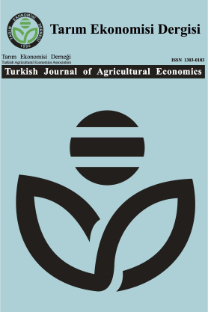Türkiye'nin Dış Ticareti ve Çevre Kirliliği: Çevresel Kuznets Eğrisi Yaklaşımı
Bu çalısmada Türkiye'nin dıs ticaretiyle çevre arasındaki etkilesim Çevresel Kuznets egrisi yardımıyla zaman serisi verileri kullanılarak analiz edilmistir. Çalısmada Türkiye'de kisi basına düsen CO emisyonu ile kisi basına düsen milli gelir, ihracat ve ithalat verileri kullanılmıstır. Sonuçlar milli gelirin 1 birim (1$) artmasının kisi basına düsen CO emisyonunu 2.69 kg. artırdıgını göstermektedir. Ancak milli gelir daha da arttıkça bu emisyon düzeyi azalmaktadır. Bu durum Türkiye'nin milli geliri ile emisyon hacmi arasındaki iliskinin Çevresel Kuznets egrisi ile uyumlu oldugunu göstermektedir. Diger yandan ticaret açıklık indeksinin1 birim artması ise kisi basına azaltmasına ragmen istatistiki açıdan önemsizdir. Bu durum Türkiye'nin üretim ve ihracat artısının kirliligi artırdıgını ortaya koymakta ve Kirlilik Sıgınagı Hipotezini dogrulamaktadır. Türkiye'de ulusal tarım politikaları içerisinde çiftçilerin ortak kullanılan kaynakların zarar görmesini önleyecek önlemlerin alınması, dıs ticarette ise ihraç edilen ürünlerde çevreyi kirletmeyen ürünlerde yogunlasmanın saglanması, ithal edilen tarımsal ürünlerde saglık ve çevreye uyum özellikleriyle ilgili standartların gelistirilip denetlenmesi gerekmektedir. Bu konuda ileride yapılacak çalısmalar Çevresel Kuznets Egrisi'ne etki eden diger faktörleri (iklim, koruma oranları, standartlar vb.) içerecek sekilde gelistirilebilir.
Turkey's Foreign Trade and Environmental Pollution: An Environmental Kuznets Curve Approach
This study examines the interaction between the foreign trade and environment employing the Environmental Kuznets Curve (EKC) and utilizing time series data. The data related to the CO emission per capita, GDP per capita, export, and import values were used in the study. The results show that CO emission per capita increases by 2.69 kg as GDPper capita increase 1 unit (1$). However, asGDPper capita increases further, the emission level starts to decrease. These findings confirm the EKC for Turkey. On the other hand, trade openness index increases the emission level per capita by 16.52 kg, while agricultural openness index has a negative impact on the level of emission although not significant. The findings also confirm the Pollution Haven Hypothesis. It is necessary to take measures to safeguard common sources used by farmers. In terms of foreign trade, the measures that will lead to specialization in less polluting sectors on export side, and designing and monitoring the sanitary and environmentally friendly standards on import side should be designed and monitored. Future studies in this area may include other factors that impact EKC, such as climate, protection levels, and standards.
___
- Cole, M. A. 2003. “Development, Trade and Environment. How Robust is the Environmental Kuznets Curve?” Environment and Development Economics. 8, 557-580.
- Cole, M. A. 2004. “Trade, the Pollution Haven Hypothesis and the Environmental Kuznets Curve: Examining the Linkages”.Ecological Economics. 48 (1), 71-81.
- Desus, S., Bussulo, M. 1998. “Is There a Tradeoff between Trade Liberalization and Pollution Abatement? A Computable General Equilibrium Assessment Applied to Costa Rica”,Journal of Policy Modeling:20 (1): 11- 31.
- Grossman, G. M. and Krueger, A. B. 1991. Environmental Impact of a North American Free Trade Agreement.Working Paper 3914. NBER, Cambridge.
- Krissoff, B., Ballenger, N., Dunmore, J. and Gray, D. 1996. Exploring Linkages among Agriculture, Trade, and the Environment: Issues for the Next Century Agricultural Economics Report No. ERS, Washington, D.C.,AER738 .
- Kumbaroglu, G. S. 2003. “Environmental Taxation and Environmental Effects:ACGE Analysis for Turkey”. Journal of Policy Modeling,25, 795-80.
- Kuznets, S. 1955. “Economic Growth and Income inequality”,American Economic Review,45(1), 1-28.
- Kuznets, S. 1955. “Economic Growth and Income inequality”,American Economic Review,45(1), 1-28.
- Lankoski, J. 1997. Environmental Effects of Agricultural Trade Liberalization and Domestic Agricultural Policy Reforms, UNCTAD Di s c u s s i o n P a p e r s , UNCTAD/OSG/DP/126, Geneva.
- Lee, H. and Roland-Holst, D. 1997. “The Environment and Welfare Implications of Trade and Tax Policy.”Journal of Development Economics,52, 65-82.
- Paudel, K. P., Zapata, H. and Susanto, D. 2005. “An Empirical Test of Environmental Kuznets Curve for Water Pollution”. Environmental& Resource Economics, 9:507-537.
- Saunders, C.,Wreford, A., and Cagatay, S. 2006. “Trade Liberalization and Greenhouse Gas Emissions: The Case of Dairying in the European Union and New Zealand.” The Australian Journal of Agricultural and Resource Economics,50, 538-555.
- Shafik, N. and Bandyopadhyay, S. 1992. “Economic Growth and Environmental Quality: Time Series and Cross Section Evidence”. World Bank Working Paper, WPS904,Washington D.C.
- Suri, V. and Chapman, D. 1998. “Economic Growth, Trade and Energy: Implications for the Environmental Kuznets Curve.”Ecological Economics, , 25(2), 195-208.
- Torras, M. and Boyce, J. K. 1998. “Income Inequality and Pollution: A Reassessment of the Environmental Kuznets Curve”.Ecological Economics, , 25 (2):147-160.
- UN Comtrade (2006. UN Commodity Trade S t a t i s t i c s D a t a b a s e . Http://unstats.un.org/unsd/comtrade/ World Bank,World Development Indicators, CD, 2005.
- Yandle, B., Vijayaraghavan, M., and Bhattarai, M. 2007. The Environmental Kuznets Curve: A Primer. PERC Research Study, 02 01. Property and Environment Research Center
- Http://www.perc.org/perc.php?id=688 Yang, H-Y. 2001. “Trade Liberalization and Pollution:AGeneral Equilibrium Analysis of Carbon Dioxide Emissions in Taiwan”.Economic Modeling, 18 , 435-454.
- ISSN: 1303-0183
- Yayın Aralığı: Yılda 2 Sayı
- Başlangıç: 1992
- Yayıncı: Tarım Ekonomisi Dergisi
Sayıdaki Diğer Makaleler
Türkiye'de Hayvansal Üretim ve Hayvancılık İşletmelerinin Özellikleri
Türkiye'deki Tarım Ekonomisi Bölümlerinin Sıralaması
Türkiye'nin Dış Ticareti ve Çevre Kirliliği: Çevresel Kuznets Eğrisi Yaklaşımı
Şanlı Urfa İli'nde Kadınların Tarımsal Yayım Çalışmasından Yararlanmasına Etki Eden Olumsuz Etkenler
